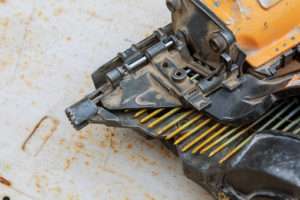This post may contain affiliate links which means I may receive a commission for purchases made through links.

If you’re planning to undertake a woodworking project, you’ll certainly need a nail gun. This is a powerful tool that drives nails into various surfaces, helping you save a lot of time. At the same time, a nail gun reduces the chances of your fingers and increases precision in your home improvement project. However, a nail gun can also be dangerous if improperly operated. For that, it’s important to understand how different nail guns work so that you can operate them safely and efficiently.
Interestingly, that’s what I’ll be looking at in this post. So, read on to discover how different nail guns work! First, here’s what you need to know about the nail loading mechanism of various nailers.
Nail Loading Mechanism
A nail gun usually features a long strip of nails that are lightly joined together. This strip of nails is loaded into the nailer through the magazine with a barrel at the end for shooting the nails. More notably, the tool has a spring at the base of the magazine that pushes the nails into the barrel.
The nails are fired through 2 different firing sources depending on the kind of nailer. That is;
- Through a power spring. When released, the spring hits the hammer, making it forcefully fire a nail through the nailer barrel.
- Using a hammer. The hammer forcefully drives each nail at the barrel at a high speed & pressure.
After the nail is driven into the material you’re working on and out of the barrel, the glue used to secure it on the strip secures it into place. Besides, the intense friction created as the nail goes through the material causes it to melt.
With that out of the way, let’s look at how different nail guns work!
How Different Nail guns work
Nail guns have a unique working mechanism depending on how they are powered. Therefore, it’s important to consider the type of nail gun you’re using to understand how it works. In that regard, nail guns can be generally classified into;
a. Electric Nail Gun
Electric nail guns are operated cordless via Li-Ion, rechargeable battery, or from an electric cord through an extension cord. A battery-powered nailer is sufficient for smaller or lighter jobs like securing trimmings. Most battery-powered devices are equipped with an electric motor that provides the driving forces behind the piston, driving the hammer to hit the nail.
That aside, electric nailer guns use a powerful spring to drive nails. As already mentioned, electric nails have a rotating motor that supports this powerful spring. When you pull the trigger and press the muzzle firmly on the material you’re fastening, the spring is released. This drives the hammer forward with adequate kinetic force to launch the nail.
As a drawback, battery-powered nail guns are not as powerful as combustions or pneumatic models, and their batteries must be recharged. Other than that, they’re more affordable and ideal for use in tighter spaces compared to other versions. In addition, they don’t put much strain on the user since they’re light in weight.
b. Combustion Powered Nail Gun
Combustion nail guns are cordless, highly portable, and use a battery and fuel canister to create internal combustion that generates power to drive a nail. The design of these devices features an interval valve that controls the amount of gas released from the canister to mix with air. Thereafter, the battery sends a spark to the spark plug to ignite the fuel. As a result, the piston is propelled downwards, driving the nail forward.
To sum up, a combustion-powered nail gun relies on internal combustion to generate adequate pressure to drive the hammer. So, instead of a plunger, the gun has a combustion chamber above the hammer. Interestingly, before this nail gun shoot, you’ve to press the muzzle onto the material you’re working on first to act as a safety mechanism.
c. Pneumatic Nail Gun
Pneumatic nailer is the most popular and powerful type of nail gun. However, this nail gun requires an air hose and a separate gas-powered air compressor to produce the forces needed to drive nails into the material.
In essence, a standard air compressor operates on the same basis as a water pump. For instance, it’s equipped with one or more piston cylinders that draw air in the air on the upstroke and pushes it out to the nail gun on the downstroke. This produces compressed air that flows into the nailer’s air reservoir through a hose.
In addition, the nail gun trigger is used to control the compression of air pressure to help move the sliding piston. As an example, the trigger drives the pressure downwards when it’s above the piston. And when you release the trigger, pressure builds below to drive the piston back into place as the nail prepares to fire the next nail.
Conclusion
Overall, it’s quite simple to understand how various nail guns work since they work similarly by generating force to drive nails into surfaces. Best of all, you only need to understand the nail-firing mechanism behind your nailer and you’re good to go. At the same time, it’s important to understand how the power behind each nail you fire is generated.
